American Whiskey The 7th Annual American Distilling Institute Conference |
|

Whiskey & Moonshine
EIGHT O’CLOCK Monday morning.
The sun is shining brightly o’er the old Kentucky home, and the WLKY weatherpersons are frantically (and joyfully) re-writing their predictions of continued showers and thunderstorms through the next few days.
For those who live in the Louisville area (or who arrived early in order to include the Kentucky Derby yesterday), it is good news indeed. Louisville recorded nearly 4 inches of rain (and major flooding) in the past few days; the Ohio River is out of its banks and seeping into the area contained by its levees. And it’s expected to peak even higher. Some roads are completely impassible.
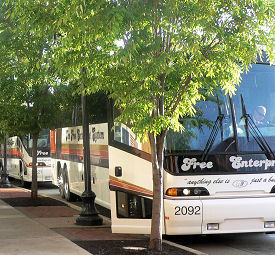 But
as we board the Free Enterprise coaches (four of ‘em!!) parked outside the
Marriott Downtown, the skies are clear and blue and look to stay that way. ADI
president Bill Owens’ celebrated knack for getting people and events to
cooperate seems to be working again, as the 7th annual American Distilling
Institute convention gets underway.
But
as we board the Free Enterprise coaches (four of ‘em!!) parked outside the
Marriott Downtown, the skies are clear and blue and look to stay that way. ADI
president Bill Owens’ celebrated knack for getting people and events to
cooperate seems to be working again, as the 7th annual American Distilling
Institute convention gets underway.
Each of the annual conferences is built around a particular
theme; this year it is bourbon, rye, and white whiskey (often wrongly referred
to as “moonshine”).
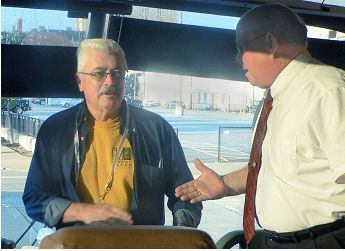 With
the growing number of craft/artisan distillers in general, and especially with
the number who’ve been at it long enough now to have a warehouse full of aged
product ready for release, the turnout this year is a bit overwhelming even for
Bill and vice president Penn Jensen, and especially for Leah Hutchinson, the
conference coordinator charged with getting well over 300 attendees and about
250 vendors and distributors where they need to be, when they need to be there.
And it pretty much all worked. Oh sure, there were some schedule changes,
overflow hotel accommodations, and so forth. But thanks to more patience on the
part of the distillers, vendors, and speakers than some of us are generally
credited with, and to the expertise and skill of the event producers (both
within ADI and also at locations we visited and especially at Huber’s Starlight,
who never ran short of food, space, or libation), and to the blessing of the
weather gods, the conference proceeded without any problems to speak of.
With
the growing number of craft/artisan distillers in general, and especially with
the number who’ve been at it long enough now to have a warehouse full of aged
product ready for release, the turnout this year is a bit overwhelming even for
Bill and vice president Penn Jensen, and especially for Leah Hutchinson, the
conference coordinator charged with getting well over 300 attendees and about
250 vendors and distributors where they need to be, when they need to be there.
And it pretty much all worked. Oh sure, there were some schedule changes,
overflow hotel accommodations, and so forth. But thanks to more patience on the
part of the distillers, vendors, and speakers than some of us are generally
credited with, and to the expertise and skill of the event producers (both
within ADI and also at locations we visited and especially at Huber’s Starlight,
who never ran short of food, space, or libation), and to the blessing of the
weather gods, the conference proceeded without any problems to speak of.
The first day is devoted to touring sites of interest. Central Kentucky is home to virtually all of the old established bourbon distillers, as well as those who supply equipment to them (and to others, such as ADI member distillers, as well).
The first stop on today’s tour is Vendome Copper & Brass
Works in Louisville . World-renowned
for the design and fabrication of industrial-size equipment, they also produce
smaller-scale units to serve distillers such as those here. 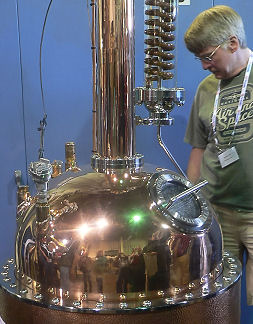 Vendome doesn’t have
“display samples” per se, nor do they offer public tours, but for this
conference they have set up several examples of stills and other distillery
equipment that have actually been produced for customers.
Vendome doesn’t have
“display samples” per se, nor do they offer public tours, but for this
conference they have set up several examples of stills and other distillery
equipment that have actually been produced for customers.
 Click
on this image to see more pictures from Vendome
Click
on this image to see more pictures from Vendome
We
are encouraged to examine them at touchy-feely range, and
 Vendome has provided
several of their personnel to explain features and answer questions in minute
detail. They get to do a lot of that, by the way, as craft distillers are almost
always also tinkerers and seat-of-the-pants engineers who love to talk about
equipment.
Vendome has provided
several of their personnel to explain features and answer questions in minute
detail. They get to do a lot of that, by the way, as craft distillers are almost
always also tinkerers and seat-of-the-pants engineers who love to talk about
equipment.
The company also provides us with much-appreciated donuts, coffee, juice, and soft drinks.
Whether batch or continuous, the still marks the end of the first part of spirit production. Part two begins and ends -- at least for aged spirits -- with the barrel. And our next stop, also in Louisville, is the Kelvin Cooperage Company.
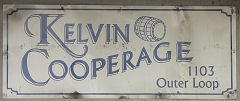 Click
on this image to see more pictures from Kelvin Cooperage
Click
on this image to see more pictures from Kelvin Cooperage
Kelvin
originated in Scotland in the early ‘60s and moved to its present location in
the early ‘90s. It is operated by the McLaughlin family. They produce new
barrels and recondition used barrels by hand.
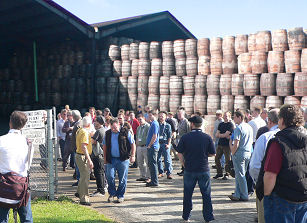 All kinds of barrels... bourbon
barrels, wine barrels, small casks, everything. Nearly all of the work is done
by hand, from toasting to charring to hoop-making to assembly. There
is a lot of activity, with dozens of coopers are working quickly at various
stages of barrel-production. Unlike with many tours, we are free to wander even
within the work area (they trust us not to stick our head into a charring pit or
a planer, but I’m certain someone would be there to stop us if we tried).
All kinds of barrels... bourbon
barrels, wine barrels, small casks, everything. Nearly all of the work is done
by hand, from toasting to charring to hoop-making to assembly. There
is a lot of activity, with dozens of coopers are working quickly at various
stages of barrel-production. Unlike with many tours, we are free to wander even
within the work area (they trust us not to stick our head into a charring pit or
a planer, but I’m certain someone would be there to stop us if we tried).
 There
are also plenty of administrators to provide guided tours for groups. In the
making of beverage spirits, the barrel plays a far more important role than just
that of a container. It is, in many ways, an important ingredient of the
finished product, and this visit gives many of us our first chance to watch
these wonderful hand-made objects being created.
There
are also plenty of administrators to provide guided tours for groups. In the
making of beverage spirits, the barrel plays a far more important role than just
that of a container. It is, in many ways, an important ingredient of the
finished product, and this visit gives many of us our first chance to watch
these wonderful hand-made objects being created.
Click on this image to see even more pictures from Kelvin Cooperage
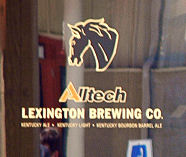 Having seen where the spirit goes in and where it comes
out, our next couple of visits will be to the homes of two Kentucky distillers,
one of the newest and smallest in the state, and one of the oldest and largest.
From the cooperage in Louisville, our buses proceed to the city of Lexington,
about fifty miles east, where we stop at Alltech Lexington Brewing and
Distilling Company.
Having seen where the spirit goes in and where it comes
out, our next couple of visits will be to the homes of two Kentucky distillers,
one of the newest and smallest in the state, and one of the oldest and largest.
From the cooperage in Louisville, our buses proceed to the city of Lexington,
about fifty miles east, where we stop at Alltech Lexington Brewing and
Distilling Company.
Alltech is actually a world-class biochemical company specializing in animal nutrition and health. They produce superior natural feed supplements, and in the process are innovators of yeasts and natural enzyme technologies.
Of course, another use for yeasts and enzymes is in the making of
beverage alcohol.
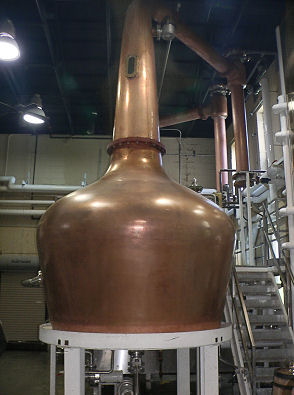 And the president and founder of Alltech, Pearse Lyons, just
happens to also be a fine Irishman with a family background in the making of
beer and ale casks. Ten
years ago, the craft-brewing bug bit
And the president and founder of Alltech, Pearse Lyons, just
happens to also be a fine Irishman with a family background in the making of
beer and ale casks. Ten
years ago, the craft-brewing bug bit
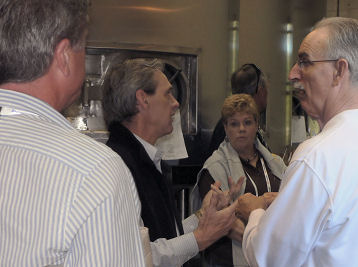 Dr. Lyons and he purchased the old silent
Lexington Brewing Company, originally built 1794, and began making award-winning
beer. In some ways, it was a hobby; but it is also a hands-on extension of
enzyme and yeast experimentation and development. Distilled whiskey came as a
natural progression. Many of the current new distillers also came into the field
from a craft-beer background and could easily relate.
Dr. Lyons and he purchased the old silent
Lexington Brewing Company, originally built 1794, and began making award-winning
beer. In some ways, it was a hobby; but it is also a hands-on extension of
enzyme and yeast experimentation and development. Distilled whiskey came as a
natural progression. Many of the current new distillers also came into the field
from a craft-beer background and could easily relate.
Alltech isn’t ready to offer finished whiskey yet; the earliest production is still aging, but they do have a coffee/chocolate cordial made with unaged distillate available to taste, and of course all three of their fine beers.
We
tour their distilling facility, with its beautiful copper pot still, made by
Forsythe and all the attendant equipment, and we have a chance to sample the low
and high wines, as well as a sample o f their whiskey in its current state of
aging.
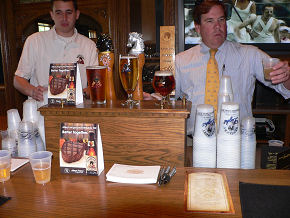
We also eat lunch there, a “box-lunch” sandwich, pickle, chips, and brownie presented in nice fabric totes with the Alltech label. What makes these totes especially “keepable” is that they are insulated and just the right size to hold a six-pack of, well, one could say for example... Lexington Brewery Kentucky Bourbon Ale.
Now that we’ve seen an example of Kentucky’s smallest and
newest, it’s time for the bus to take us a few miles northwest through Frankfort
and out to Leestown, where we will tour one of Kentucky’s largest and oldest.
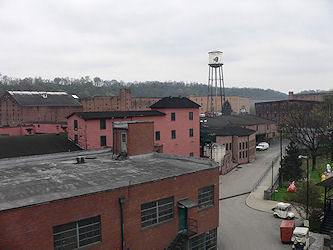 That would be Buffalo Trace, which has also been Ancient Age, Schenley, Geo. T.
Stagg, OFC, E.H. Taylor and Sons, and Carlisle since its beginnings in the 19th
century. Like many distilleries, Buffalo Trace offers a tour for visitors. They
also have what they call the “hard hat tour” for special guests who would
benefit from and enjoy it. This more comprehensive version includes access to
more difficult areas and a very detailed commentary by the tour guide, and this
is the one we are offered. As you might suspect, given the type of people the ADI group consists of, just the Q&A session at the end of the tour alone lasts longer than most of the
standard tours themselves!
That would be Buffalo Trace, which has also been Ancient Age, Schenley, Geo. T.
Stagg, OFC, E.H. Taylor and Sons, and Carlisle since its beginnings in the 19th
century. Like many distilleries, Buffalo Trace offers a tour for visitors. They
also have what they call the “hard hat tour” for special guests who would
benefit from and enjoy it. This more comprehensive version includes access to
more difficult areas and a very detailed commentary by the tour guide, and this
is the one we are offered. As you might suspect, given the type of people the ADI group consists of, just the Q&A session at the end of the tour alone lasts longer than most of the
standard tours themselves!
From Buffalo Trace, our Free Enterprise coaches (“anything else is just a bus ride”) bring us home to the Marriott and Galt House hotels. As we pass across the levy in Frankfort, we can see areas where the Kentucky River has flooded some of the buildings along the bank. Buffalo Trace itself suffered some losses, including their running water -- which left no bathrooms and only port-a-pot facilities for both the employees and folks on the tour.
After returning to Louisville, many of the members attended the Michael Jackson Internship Benefit dinner, held at the 21-C Museum Hotel which is a separate function from the main conference activities. Those not attending had the night to explore Louisville’s vibrant and sophisticated downtown bars and restaurants, visit with one another, or just chill out after a very full and exciting day. And remember... the bus leaves tomorrow at 8:30 sharp; be on it!
TUESDAY MORNING, VERY EARLY
VERY, VERY EARLY
Well, here are the buses.
And we’re on ‘em.
And we’re leaving.
And it’s 8:30, sharp.
But about the only one who’s sharp is the bus driver (a
gentleman known as “Beanie” on our bus). Today is even prettier that yesterday.
And it is evident that not all of us went to sleep early last night. Today we
have only one destination, the Jim Huber’s Starlight Distillery in Indiana,
about an hour across the Ohio river. And fortunately, the folks at Huber are
well-prepared for the likes of us.
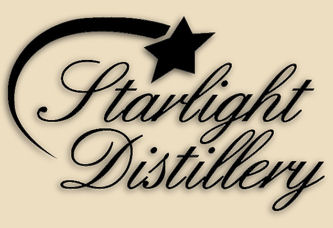 The distillery is part of a much larger Huber
family-owned complex in a drop-dead gorgeous area of trees, clearings, lakes,
creeks twisting roads that also features a farm, a petting zoo, a woodworking
mill, berry fields, fruit orchards, and a winery. All are designed to be used
for presentation to visitors. The orchards and grapevines led to the winery, and
from that to distilled brandies. And not too long after that to distilled grains
and whiskey. But what really makes Huber Starlight so desirable for us is that
the whole operation is designed for just such conferences and large events. They
are staffed to handle it, and they do so expertly. The size of our group is barely
a challenge for them, and the service is both efficient and invisible. Four
busloads of sleepy morning people arrive this morning to find coffees, juices,
breads, biscuits and gravy waiting for us. And when those are gone they just
keep on bringing out more.
The distillery is part of a much larger Huber
family-owned complex in a drop-dead gorgeous area of trees, clearings, lakes,
creeks twisting roads that also features a farm, a petting zoo, a woodworking
mill, berry fields, fruit orchards, and a winery. All are designed to be used
for presentation to visitors. The orchards and grapevines led to the winery, and
from that to distilled brandies. And not too long after that to distilled grains
and whiskey. But what really makes Huber Starlight so desirable for us is that
the whole operation is designed for just such conferences and large events. They
are staffed to handle it, and they do so expertly. The size of our group is barely
a challenge for them, and the service is both efficient and invisible. Four
busloads of sleepy morning people arrive this morning to find coffees, juices,
breads, biscuits and gravy waiting for us. And when those are gone they just
keep on bringing out more.
When last I attended an ADI conference (it was the rum conference in 2007), there were speakers and presentations all day long, back to back. This year there are three times as many, arranged as “breakout” sessions. The upside is that a lot of information can be put out and folks can pick those that are of particular interest to them. The downside is that quite often those sessions turn out to be running parallel to one another. I have an opportunity to hear Max Watman and Matthew Rowley talk about the books they’ve written on moonshine, but to do so I have to skip hearing what Wes Henderson, Mike Cameron, and Scott Harris have to say about opening a distillery. And presentations on labels, packaging, publicity and marketing, the pros & cons of high-proof blending, and stories of prohibition moonshining in Minnesota are all available, but each requires that I skip or only half-attend the others. I fully enjoy Lincoln and Wes Henderson’s introduction to the effects of different types of oak barrels on high-quality Suntory whiskey, but I would have also liked to have seen the Heritage panel discussion scheduled for the same time.
I feel like a kid in a candy store; there is just so much to see and do, and nowhere near enough time to do it.
Meanwhile, all during the afternoon Jim Blansit and Sherman Owen were outside next to the still building, cooking up a pot of corn mash as a demonstration for those not familiar with what that entails. Even those who ARE familiar often use different methods to do it, and so there is plenty of discussion going on.
And the Vendor Expo room has grown from a handful of booths set up in the buffet room three years ago to over 42 displays in a much larger dining room. Lots of glassware, corks & stoppers, grain varieties, yeast, essential oils, small alembic stills, not-so-small distilling equipment, casks and barrels, publications, printing & labeling services, and all sorts of things of interest to distillers. This room is always well-occupied.
The evening begins with the awards ceremony, where the results of yesterday’s judging are announced. Also, there were a few donated items auctioned to add to the funds raised for the Michael Jackson internship by the special dinner last night.
After that we enjoy a delicious banquet dinner, and then they open the bar for sampling of all the micro-distillers’ products. There are a lot of examples. Even with very discrete pours it adds up to a lot of liquor.
I don’t really remember much after that.
WEDNESDAY
For those who are flying back home today, the Marriott has provided secure storage for luggage so that we can check out before traveling to Huber Starlight this morning without having to bring all our luggage with us. The buses roll at about 8:15, but this time there are only two of them. Many guests have to take earlier flights back and will miss today’s events.
I very much enjoy listening to Ralph Erenzo and his son Gable share stories of how they market their Tuthilltown spirits to key bartenders and restauranteurs, although I would also have liked to see the debate between “beer wash” vs “corn mash” going on at the same time between Rory Donovan of Peach Street, Jake Norris of Stranahan’s, and Chip Tate of Balcone’s Spirits. Later, historian Michael Veach walks us through the years from the first Kentucky settlers to day-before-yesterday, pointing out how branding techniques are nothing new in this industry, and that much of bourbon’s mythology is more likely the result of imaginative marketing than actual fact. At the same time, one could listen to Eric Watson speak about proper mashing techniques for whiskey production. Unfortunately (as a number of members noted), one had to choose between those two.
Another fine lunch from the Huber kitchens and the buses began rolling to take up back to the real world.
There's another one of these coming up in 2012. I'm gonna be there!
![]()
 |
|
|
Story and original photography copyright © 2010 by John F. Lipman. All rights reserved. |
|




